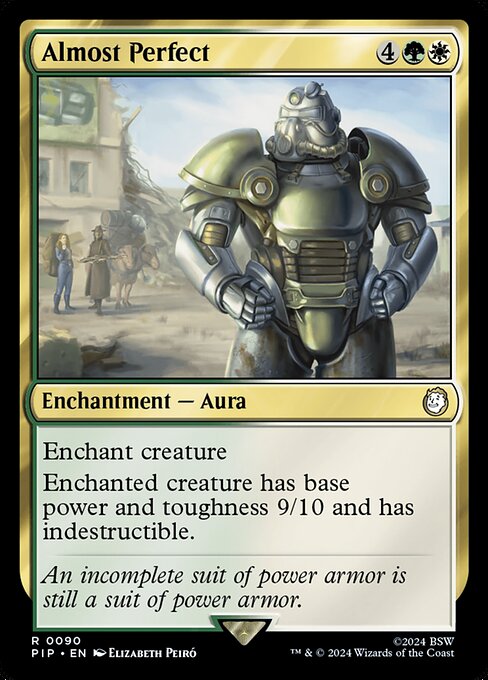
Image courtesy of Scryfall.com
Modeling MTG Deck Outcomes with a Rare Enchantment Aura
When you’re tracking the trajectory of a MTG deck, a single card can swing the entire math in your favor—or complicate it in delicious ways. Almost Perfect, a green-white aura from the Fallout commander-compatible line, is one of those cards that makes you rethink how you model outcomes. With a mana cost of 4 generic plus {G}{W} (six mana total), this Enchant aura lands in the green-white wheelhouse that loves big bodies, tenacity, and a little bit of armor for the board. The enchanted creature becomes a 9/10 and, crucially, indestructible. In practical terms, you’re looking at a stable, hard-to-remove threat that resists the usual sweepers and alpha-strikes—precisely the kind of anchor you want when you’re forecasting win rates and battleground control in long games 🧙♂️🔥.
From a deck-design perspective, Almost Perfect is a study in risk-adjusted power. The cost is not cheap, and you need to dedicate a board slot to a creature capable of carrying the aura. Yet the payoff is outsized: indestructible ensures the creature survives combat damage that would otherwise erase your plan, and the 9/10 baseline turns even modest boards into something scary. If you’re modeling deck outcomes, this card is less about “how fast can I win” and more about “how consistently can I lock in a stable, unstoppable late-game board presence.” In other words, it helps you project paths to victory under removal-heavy metas and when the game stretches into the late turns ⚔️🎲.
Let’s talk a bit about the why behind the numbers. Six mana is a meaningful commitment, but the payoff is multi-layered. First, you gain a tangible shield: indestructible isn’t invulnerability, but it shouts resilience in the heat of a post-sweep refresh. Second, the base creature size—9/10—provides near-unstoppable force in combat, especially when you sandwich the aura with supportive “safety” elements from GW colors such as protection from colors, creatureETB effects, or anthem-style buffs. Third, the aura’s existence invites risk-managed plays: you’ll want to guard it against enchantment removal, or you’ll have traded a far-too-expensive threat for a temporary respite. For deck-out modeling, that dynamic translates into a predictable ceiling and a meaningful floor—enough to trust the card as a deck-finisher that may weather a sweep or two before the endgame arrives 🧙♂️💎.
“In the realm of aura-driven inevitability, Almost Perfect asks you to count both the armor and the consequence. You’re not just stacking stats; you’re building a fragile empire that the game can still pry loose—if you’re not careful.”
Speaking to the broader design of Almost Perfect, its Fallout set label sits alongside a flavorful narrative: an incomplete suit of power armor still stands as a dangerous, capable machine. The flavor text—“An incomplete suit of power armor is still a suit of power armor”—resonates with players who love the math of incomplete information: even imperfect tools can win games when you optimize draw sequencing and timing. The art by Elizabeth Peiró captures that tension—massive, gleaming armor juxtaposed with the fragility of contingency—the perfect metaphor for modeling uncertainty in deck outcomes 🧨🎨.
From a collector’s lens, Almost Perfect sits in the rare slot within the Pip (Fallout) set, with foil and non-foil options reflecting typical demand for commander-grade pieces. While its price on the collecting market can hover in the sub-dollar range in casual times, its strategic value in simulations is priceless. For players who enjoy crunching numbers and testing hypothetical matchups, the card’s stability under threat and its high-impact final-approach allows you to stress-test win conditions, removal resilience, and combat math in a controlled, repeatable way. In practice, you’ll find that modeling with this aura yields insights into how often a board state with indestructible 9/10 power can survive multiple rounds, even when opponents present mass removal or mass buffs. The result: a more nuanced expectation curve and a better grasp of your deck’s ceiling 🧙♂️💎.
As we explore these outcomes, it’s worth noting GW’s identity. The color pair is renowned for synergy between life-gain, board control, and robust creature protection. Almost Perfect fits squarely into that palette by elevating a single creature into an almost insurmountable finish line, while also giving you a reason to craft your mana curve and removal suite with precision. When you model deck outcomes that include this card, you’re not just counting a big number; you’re simulating a fortress that only breaks when you stumble on tempo or mismanage enchantment protection. And that’s where the fun begins—tuning your list to maximize the chance that the fortress stands tall when the game matters most 🧭⚔️.
For readers who enjoy cross-pertilization, this article sits at an interesting intersection with broader strategy discussions in five linked pieces from our network. It’s the perfect companion to conversations about risk design, creative constraint, and the tension between innovations in red and blue in instant-design strategies, as well as practical limits on the guardrails we place around powerful effects. If your curiosity is piqued by how incentive structures shape deck choices, you’ll find fertile ground in the linked reads, whether you’re exploring innovation risk, the mechanics behind safeguards in MTG, or the physics of color-limited decks 🧙♂️🔥.
Phone Click-On Grip Reusable Adhesive Phone Holder KickstandMore from our network
- https://crypto-acolytes.xyz/blog/post/ted-cruz-blocks-bill-expanding-privacy-protections-for-all-americans/
- https://blog.digital-vault.xyz/blog/post/bolt-bend-evaluating-innovation-risk-in-red-instant-design/
- https://blog.rusty-articles.xyz/blog/post/serperior-vstar-early-game-advantage-strategies-for-wins/
- https://blog.digital-vault.xyz/blog/post/designing-under-limits-the-mechanics-behind-brokers-safeguard-in-mtg/
- https://crypto-acolytes.xyz/blog/post/luminosity-unveiled-by-temperature-and-radius-in-a-scorpius-giant/